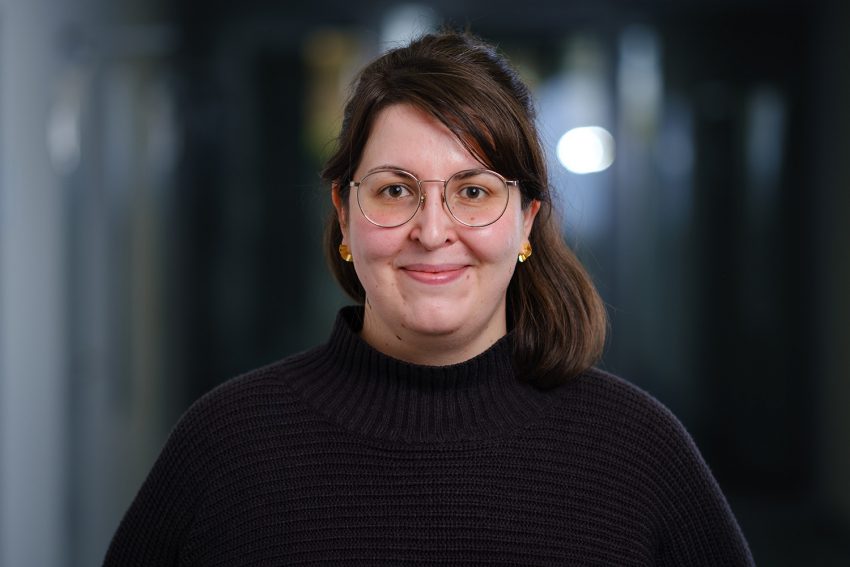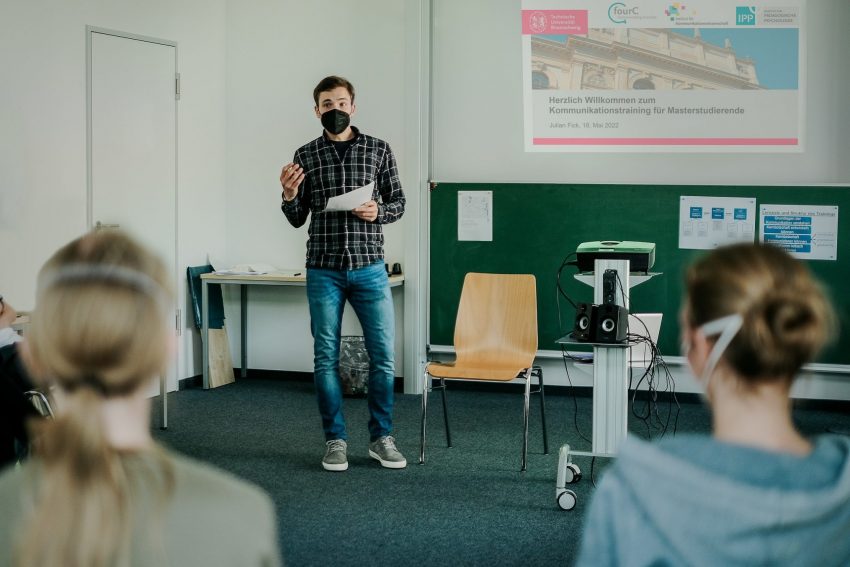Interesting Facts about Science Communication #GetTUknow Dr. Friederike Hendriks and the Junior Research Group "fourC"
The name of the Junior Research Group “fourC” stands for Communicating Scientists: Challenges, Competencies, Context – and this is exactly what the Junior Research Group is concerned with. “FourC” investigates how science can be communicated successfully. In addition, the research group develops trainings that strengthen the communication skills of students and researchers. In this interview, Dr. Friederike Hendriks, head of the Junior Research Group, reports on the work of the Junior Research Group and explains what constitutes good science communication.

Dr. Friederike Hendriks is the head of the Junior Research Group “fourC”. Photo credit: Lennart Banse/TU Braunschweig
Dr. Hendriks, why is science communication important?
This is a very complex question, essentially there are two reasons why science communication is of particular importance. Firstly, science is publicly funded and aims to develop society. In this respect, society has a legitimate right to have science communicated to it. Secondly, science provides solutions to social problems. Of course, society also has a legitimate interest in this. Moreover, science can only contribute as a solution partner through transparency and communication.
In addition, the communication requirements for scientists have become much more complex in recent years. They should communicate their research themselves and not exclusively seek out mediators such as press offices or journalists. Therefore, as a Junior Research Group, we offer training in science communication so that scientists can fulfil this communication task. And on the other hand, we do basic research on the requirements that science communication places on individual researchers.
How do you research communication?
We conduct interdisciplinary research using the theories and methods of psychology and communication science.
Firstly, we focus on the question of what characteristics make researchers successful communicators. To this end, we conduct interviews and surveys in which we ask researchers how, why and with what motivation they communicate. This also involves their professional self-image. This research is primarily qualitative.
On the other hand, we are interested in studying the impact of communication. What makes science communication trustworthy and understandable? How do scientists need to communicate so that their research is received as it should be? To answer these questions, we are planning quantitative surveys and experimental studies. The results can help us decide what to teach scientists in training. By including empirical studies in training development, we ensure that the training is evidence-based.
And finally, we also research our trainings themselves. This involves classic pedagogical-psychological evaluation research. This means that we test once before the training and once after the training, and determine a positive learning success by whether the measured knowledge and skills are higher after the training than before.
What are indicators of good communication?
Within the Junior Research Group, we have approached the measures of good communication from the impact side. What should be achieved with the communication? After all, we want to achieve that people understand the scientific content we want to communicate to them and arouse their interest. At the same time, it is important that researchers present themselves as credible and trustworthy in their communication.
The quality and success of science communication are difficult to define and can hardly be grasped as an ideal construct. They also depend on the goals that researchers have for their own science communication. In future, we will include reflection on this in our training courses.
What best practice examples of good science communication can you think of?
Before and during the Corona pandemic, we noticed a variety of scientists communicating in completely different ways and addressing different audiences. There are many different ways to engage in science communication. Not every scientist has to speak on the news. It is important to find a format or an area in which one feels personally comfortable and can communicate the respective content in a way that is appropriate for the target group. There are no ideal types here. Good communicators find a way of communicating that suits them and thus appeals to the desired target group.
A C in “fourC” stands for challenges – what are the challenges of science communication?
The biggest challenge is time. Scientists are already busy with many tasks in research and teaching, so that there is little or no time left for responsible science communication. An important resource that can compensate for this problem are communicators in press offices or directly in the projects and research areas whose main task is to communicate science.
Other challenges lurk in communication skills. We address these in our communication training. These skills are often simply a matter of practice. Here we want to convey confidence.
What content is taught in your science communication trainings?
In the trainings, we build basic skills. We teach strategies on how participants can learn to communicate science in an understandable and interesting way. Ultimately, at the end of our training, they should be able to apply these communication strategies in a short pitch presentation. For this purpose, these strategies are practised in exercises with video feedback and small groups.
Besides these competences, it is also about building up knowledge on science communication and reflecting on oneself and one’s research. What makes my research interesting and how do I highlight what is interesting? How can I communicate my research in a comprehensible way? Where can I take away complexity? We focus on practical exercises, so that by the end of the course, the participants have developed a concrete product, but have also learned strategies that they can apply in other communication situations.

In training sessions, JRG “fourC” teaches the basics of good science communication. Photo credit: Lennart Banse/TU Braunschweig
Who is the training aimed at?
At the moment, the training is aimed at Master’s students. We believe that students should already learn how to communicate science well. Our participants so far have come from many different fields of study, which enriches the training even more. We are currently working on offering the training to doctoral students and post-docs as well.
What is the aim of the Junior Research Group “fourC”?
First, as I said, we are developing science communication trainings. In the end, we would like to have developed and be able to offer evidence-based, well-evaluated modules for the most important science communication competences.
Secondly, we want to ask ourselves fundamentally what characterises communicating scientists, what are their needs and challenges, what is their attitude towards science communication and how can they be introduced to it. Here we are doing basic research, which is the basis for the development of the training.
You studied in Münster, then went to Kiel and are now in Braunschweig. What brought you here?
“FourC” provides the perfect framework for my research. I studied Psychology in Münster and then already did an interdisciplinary doctorate with an interface to communication science on a topic of science communication, namely trust in science. This topic still preoccupies me. In this context, I also met Monika Taddicken, the head of the Institute of Communication Science. In Kiel, I then worked on a project dealing with science communication from the perspective of science didactics. At the moment, I am again involved in the Kiel Science Communication Network as a Research Fellow.
Basically, I have always worked in an interdisciplinary way. When I saw the job advertisement for “fourC”, I knew it was the perfect job for me.
What makes TU Braunschweig the ideal research field for science communication?
With its broad, application-oriented research, TU Braunschweig offers a great basis for researching science communication in the various disciplines. In discussion with students and other researchers, we can consider what the needs, wishes and requirements are for science communication from a researcher’s perspective. I also find that my colleagues in all faculties are incredibly interested in our topics and open to exchange and cooperation. I am very grateful for that.
Thank you very much for the interview.

